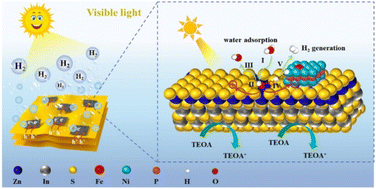Modulating and optimizing 2D/2D Fe-Ni2P/ZnIn2S4 with S vacancy through surface engineering for efficient photocatalytic H2 evolution†
Abstract
Photocatalytic hydrogen release provides a sustainable and promising method for solar energy fuels and raw materials. The reasonable construction of nanocomposite photocatalysts with rapid charge transfer and broad solar response capability is of great significance for the efficient conversion of solar energy to chemical energy. Herein, for the first time, different metal ions (Fe, Co, and Mn) are doped in situ through the surface modification strategy to change the electronic structure and d band center of the cocatalyst Ni2P, which then adjusts the surface state of ZnIn2S4 nanosheets with S defects to accelerate the surface photocatalytic hydrogen evolution reaction. It is impressive that the constructed Fe-doped Ni2P/ZnIn2S4-Vs ultra-thin 2D/2D nanosheet structure has the best photocatalytic hydrogen evolution activity and lasts for 20 h, and its hydrogen evolution rate can reach 4548.75 μmol g−1 h−1, which is 11.51-fold higher than that of pristine ZnIn2S4. Moreover, the simulation results indicate that Fe doping replaces the Ni site and also confirm the path of charge directional transfer. The composite catalyst optimizes the Gibbs free energy of the intermediate state of the hydrogen evolution reaction, thus improving intrinsic photocatalytic activity. This study provides guidance for the construction of a highly efficient hydrogen evolution photocatalyst.

- This article is part of the themed collections: Journal of Materials Chemistry A Emerging Investigators and #MyFirstJMCA


 Please wait while we load your content...
Please wait while we load your content...